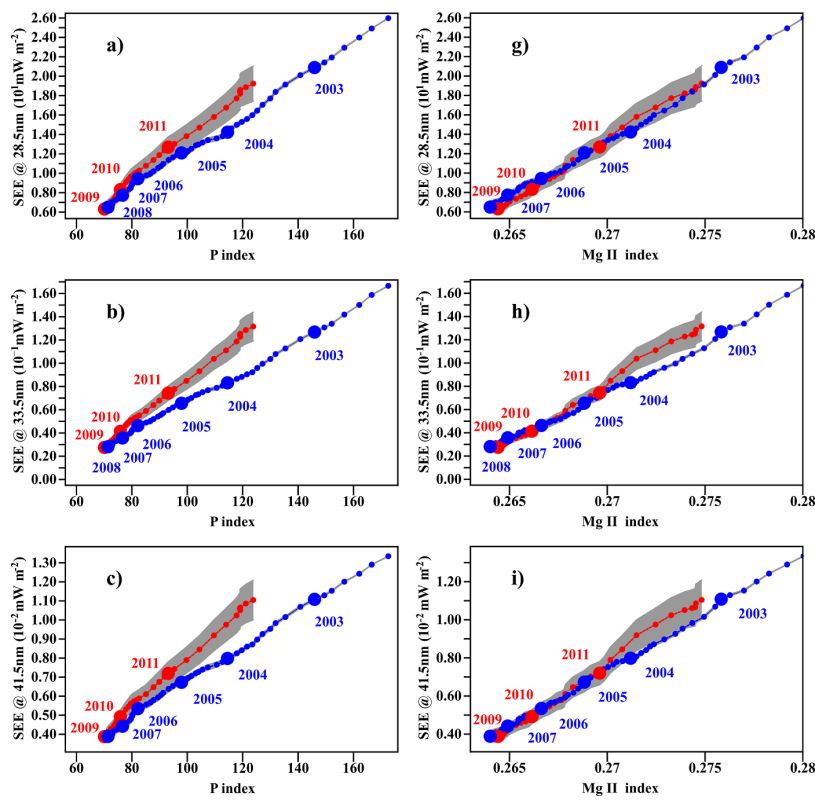不同于较为恒定的太阳可见光辐射,太阳极紫外(EUV)辐射在高低年有可观变化,而后者正是影响地球热层大气和电离层状态的主要能量源。2009年以来太阳活动性显著偏低,使第24个太阳活动周成为太空时代以来最弱的活动周。因此一个重要的问题是,此时太阳的紫外辐射谱是否发生了根本性的变化,其与太阳黑子数、F10.7、P指数((F10.7+F10.781)/2)和MgII指数等众所周知的代理参数的关系是否也相应改变。
太阳EUV辐射需要在太空中测量,本工作即使用近年来的卫星观测数据,包括TIMED卫星搭载的SEE仪器(Solar EUV Experiment)、SORCE卫星上的SOLSTICE(Solar Stellar Irradiance Comparison Experiment)以及SDO卫星上的EVE(EUV Variability Experiment)。TIMED/SEE的数据覆盖第23周后半段和第24周的前半段,比较TIMED/SEE观测的辐射谱在两个活动周间的差异,发现相同的P水平下短波长辐射(30-50nm)在第24周更强,而长波长辐射(60-120nm)偏弱。特别是三条日冕辐射线(Fe XV at 28.4 nm,41.7 nm,Fe XVI at 33.5 nm),它们在第24周相对P指数有明显的偏高。
进一步考察EUV辐射与P和MgII指数的关系发现,使用MgII指数,则上述三条日冕线在第24周则不再偏高;而使用P指数,则可消除长波段中一些色球发射线的活动周差异。这表明对于第23和24活动周来说,P和MgII指数可分别较好的反映色球和日冕过渡区的发射线,这与前人的一般结论是相反的。其原因是否与第24周的太阳活动特殊性有关还需进一步的研究。

分别以P和MgII指数为参考,三条日冕发射线强度在两活动周间的比较(SC24为红色,SC23为蓝色)
另外,在长波段中较强的发射线,如lyman-alpha线(121.6nm),与SORCE/SOLSTICE相比TIMED/SEE的观测结果可能偏低;SOHO/SEM观测的26-34nm及0.1-50nm的光子通量值亦在第24周表现出偏低。这可能都是由于仪器退化的效应没有被恰当的纠正,对于覆盖一个太阳活动周这样的长期卫星观测来说,这确实是一个难以解决的问题,也对太阳辐射和地球大气的长期研究造成了不利的影响。
该文章发表在Journal of Geophysical Research: Space Physics上(http://onlinelibrary.wiley.com/doi/10.1002/2015JA022231/abstract),文章作者为:黄建平,郝永强,张东和,肖佐。
Huang, J., Y. Hao, D. Zhang, and Z. Xiao (2016), Changes of solar extreme ultraviolet spectrum in solar cycle 24, J. Geophys. Res. Space Physics, 121, 6844–6854, doi:10.1002/2015JA022231.
ABSTRACT
Following the extreme solar minimum during 2008–2009, solar activity keeps low in solar cycle 24 (SC24) and is making SC24 the weakest one of recent cycles. In this paper, using observations from Earth-orbiting satellites, we compare the solar extreme ultraviolet (EUV) irradiance between SC23 and SC24 and investigate the solar cycle change of linear dependence of EUV on the P ((F10.7 + F10.7A)/2) and Mg II core-to-wing ratio indices. The Bremen composite Mg II index is strongly correlated with P over the two solar cycles, while this is not the case for the Laboratory for Atmospheric and Space Physics (LASP) composite Mg II index, so we focus on the different dependence of EUV on the P and LASP Mg II indices. As a result we find that three coronal emissions (Fe XV at 28.4 nm and 41.7 nm and Fe XVI at 33.5 nm) brighten in SC24 relative to P; i.e., the magnitude of irradiance is higher than in SC23 at the same level of P. But relative to the LASP Mg II index, these emissions show no appreciable solar cycle differences. By contrast, the H I Lyman α at 121.6 nm dims in SC24 relative to the LASP Mg II but shows identical dependence on P in the two solar cycles. This result seems to contradict a well-accepted fact that chromospheric and transition region emissions are better represented by the Mg II index and coronal lines by F10.7. For the different solar cycle variability of EUV in SC24, whether it is caused by source changes on the Sun is still unclear, but we suggest that it needs to be considered in proxy modeling of the EUV irradiance and aeronomic studies.

